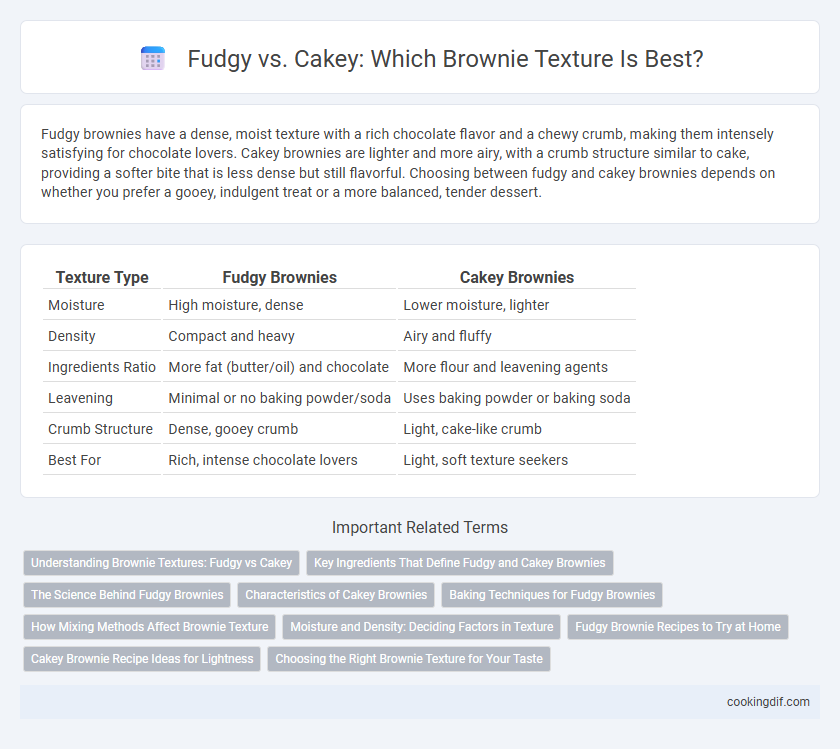Fudgy brownies have a dense, moist texture with a rich chocolate flavor and a chewy crumb, making them intensely satisfying for chocolate lovers. Cakey brownies are lighter and more airy, with a crumb structure similar to cake, providing a softer bite that is less dense but still flavorful. Choosing between fudgy and cakey brownies depends on whether you prefer a gooey, indulgent treat or a more balanced, tender dessert.
Table of Comparison
| Texture Type | Fudgy Brownies | Cakey Brownies |
|---|---|---|
| Moisture | High moisture, dense | Lower moisture, lighter |
| Density | Compact and heavy | Airy and fluffy |
| Ingredients Ratio | More fat (butter/oil) and chocolate | More flour and leavening agents |
| Leavening | Minimal or no baking powder/soda | Uses baking powder or baking soda |
| Crumb Structure | Dense, gooey crumb | Light, cake-like crumb |
| Best For | Rich, intense chocolate lovers | Light, soft texture seekers |
Understanding Brownie Textures: Fudgy vs Cakey
Fudgy brownies contain higher fat-to-flour ratios, using more butter and less flour, resulting in a dense, moist texture rich with chocolate intensity. Cakey brownies incorporate more flour and leavening agents like baking powder, yielding a lighter, airy crumb similar to chocolate cake. Understanding the balance of ingredients highlights how fat, flour, and leavening influence brownie texture, guiding bakers to achieve either a fudgy or cakey consistency.
Key Ingredients That Define Fudgy and Cakey Brownies
The key ingredients that define fudgy brownies include a higher fat-to-flour ratio, often achieved with more butter and less flour, alongside a generous amount of melted chocolate or cocoa to create a dense, moist texture. Cakey brownies rely on a higher proportion of flour and eggs, with less fat, providing a lighter, aerated crumb reminiscent of cake. Sugar types and baking time further influence texture, where powdered sugar contributes to cakey softness and shorter baking times retain fudginess.
The Science Behind Fudgy Brownies
Fudgy brownies owe their dense, moist texture to a higher fat-to-flour ratio, with butter and chocolate melting into a rich matrix that limits gluten development. The reduced flour and sugar content also contribute to a lower crumb structure, resulting in the characteristic gooey interior. This science behind fudgy brownies highlights the role of fat saturation and minimal leavening, creating a chewy, indulgent bite.
Characteristics of Cakey Brownies
Cakey brownies have a lighter, airy texture with a crumb that resembles traditional cake, often achieved by using more flour and leavening agents like baking powder. They tend to be less dense and more tender compared to fudgy brownies, offering a soft bite that balances moisture and firmness. This texture appeals to those who prefer a less rich, more bread-like dessert experience with a crisp top layer.
Baking Techniques for Fudgy Brownies
Achieving fudgy brownies relies on specific baking techniques such as using a higher fat-to-flour ratio and minimal leavening agents to create a dense, moist texture. Incorporating melted butter and reducing mixing time prevents excess air incorporation, which keeps the batter compact and rich. Baking at a slightly lower temperature and removing brownies from the oven while they're still slightly underbaked ensures a gooey, fudgy center.
How Mixing Methods Affect Brownie Texture
Mixing methods significantly influence brownie texture by controlling gluten development and moisture distribution. Stirring just until ingredients combine results in fudgy brownies with dense, moist interiors, while more vigorous mixing incorporates air and activates gluten, producing cakey brownies with a lighter, crumbly structure. Using melted butter and minimal mixing enhances richness and chewiness characteristic of fudgy brownies.
Moisture and Density: Deciding Factors in Texture
Fudgy brownies have a higher moisture content and greater density, resulting from a higher fat-to-flour ratio and a lower baking temperature, which creates a rich, gooey interior. Cakey brownies contain more flour and leavening agents like baking powder, producing a lighter, more aerated texture with less moisture retention. The balance of butter, sugar, and eggs determines the fudginess or cakiness by controlling the overall moisture and density of the final brownie.
Fudgy Brownie Recipes to Try at Home
Fudgy brownie recipes emphasize high fat content from butter or oil and minimal flour to achieve a dense, moist texture that melts in your mouth. Ingredients like melted chocolate, brown sugar, and eggs create a rich, gooey interior distinct from cakey brownies, which rely on baking powder or soda for a lighter crumb. Popular fudgy options to try at home include classic Brooklyn-style brownies, salted caramel fudge brownies, and triple chocolate variants featuring chunks or swirls for intense flavor and a chewy bite.
Cakey Brownie Recipe Ideas for Lightness
Cakey brownies achieve a lighter texture by incorporating ingredients such as baking powder or baking soda to introduce airiness. Using cake flour instead of all-purpose flour also contributes to a tender crumb, enhancing the brownie's softness. Experimenting with egg whites or yogurt can provide moisture while maintaining a fluffy consistency, perfect for those seeking a less dense dessert.
Choosing the Right Brownie Texture for Your Taste
Selecting the right brownie texture depends on personal preference and baking technique. Fudgy brownies boast a dense, moist interior with a rich, chocolatey flavor ideal for those who enjoy a gooey bite, achieved through higher fat content and less flour. In contrast, cakey brownies have a lighter, airier crumb with a balanced sweetness, perfect for fans of a spongy texture, typically made using more flour, baking powder, and eggs.
Fudgy vs Cakey for brownie texture Infographic

 cookingdif.com
cookingdif.com